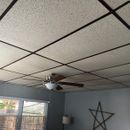Adding XPS on interior side of flat roof ceiling
Howdy,
St. Louis, MO: Climate Zone 4
I’m about to tackle two projects on my rear addition but was hoping for some guidance before I start tearing things apart.
The first project will be stripping and replacing the rolled roofing as I can see water stains on the drop ceiling where the addition meets the house. Whoever installed this roof made no effort to prevent wind-driven rain from getting back there. Anyways, pretty simple project – hopefully I don’t find anything too exciting when I strip the old roofing.
The second project is to replace the drop ceiling with drywall, replace any dirty/wet insulation as needed, probably fur out the rafters (or joists? whichever is the appropriate term for a very low pitch room ceiling) for more fiberglass insulation, then add 1/2″ to 1″ of XPS to the bottom/skinny side of the rafters/joists to air seal and help with thermal bridging before drywalling.
Hopefully this makes sense. Think of it like this, if you’re looking straight up at the ceiling: drywall, XPS, cavity insulation, roof deck, roof felt/IWS, rolled roofing.
For context, currently, there is foil-faced R19 fiberglass insulation installed in between the rafters/joists (16″ oc) and more kraft faced R19 fiberglass insulation laid perpendicular to the rafters/joists on top of the drop ceiling. I’m not sure if the drop ceiling and additional insulation was an afterthought, but they didn’t do a great job ensuring the additional insulation completely covered the top of the drop ceiling. I can see how that job would’ve been a PITA though.
Can anyone let me know if they foresee an issue with that plan? I know XPS is typically installed on the exterior of the roof deck, but in this case, honestly, it’s just a lot more work + materials to do it that way and I can’t see any benefit that would justify the added time and expense.
Please let me know what you guys think! Any help appreciated.
Thank you,
Zack
GBA Detail Library
A collection of one thousand construction details organized by climate and house part












Replies
I wish people would just stop thinking of XPS as a reasonable product- it isn't. It is BY FAR the least green insulation product in common use today, with 3x the CO2e footprint of second-worst HFC blown closed cell polyurethane spray foam, 5x that of HFO-blown closed cell polyurethane:
https://materialspalette.org/wp-content/uploads/2018/08/CSMP-Insulation_090919-01.png
What's more, it's only warranteed to 90% of initial R at 20 years, and will eventually perform the same as EPS of similar density (R4.2/inch) at full depletion of the blowing agents.
Foil faced polyisocyanurate is blown with low-impact hydrocarbons, and uses about half the polymer per R of closed cell spray polyurethane, and a higher R/inch than EPS or XPS. That makes it more on par with fiberglass or mineral wool batts from greenhouse gas footprint perspective.
Is there a vented micro-attic between the ceiling joists and rafters?
Putting the foam on the exterior of the structural roof deck in a cathedralized ceiling protects the roof deck from both exterior & interior moisture drives, and allows the assembly to be set up to dry toward the interior, provided there is sufficient R-value to the exterior foam. In zone 4 a minimum of 30% of the total-R has to be on the exterior to be able to use a class-III vapor retarder (standard interior latex paint) as the interior side vapor retarder. So if those are 2x6 rafters, if you're keeping the R19s (which only perform at R18 when compressed to 5.5", and even worse if it doesn't have a full air barrier on both sides of the batt), you would need at least R8 (more is better) on the exterior,. ratio of R8/(R8 +R18)= 31%. If installing R23 rock wool it would take at least R10.
So, 2" of foil faced polyiso (R12-R13) secured to the structural roof deck with a 5/8" plywood or OSB nailer-deck through screwed to the structural roof deck with pancake head timber screws would allow the use of a higher permeance ceiling, with a much more resilient roof. An impermeable self-healing fully adhered membrane on the structural roof would be nearly guaranteed leak-proof in that stackup. The nailer deck could get the usual #30 felt underlayment for asphalt roofing.
A half inch or inch of foam isn't going to do a whole lot for the thermal performance, and if insulating from the interior side the roof deck MUST be vented on the underside, which may be difficult to do adequately for a low-pitched roof that terminates against a wall on the high side. The alternative is to use (preferably HFO-blown) closed cell foam on the underside of the roof for a minimum of 30% of the total R.
Hi Dana,
Thanks for the detailed response. Honestly, I don't prefer XPS over any of the other foam board products. Thanks for the foil-faced poly iso suggestion.
This flat roof does not have any venting that I can see. There might be an air space between the fiberglass insulation and the roof deck but I doubt it. To be perfectly transparent, I'm not very optimistic about what I might find once I start pulling down the existing cavity insulation.
My main concern with adding insulation on the exterior is that the soffit/gutter on the house would prevent the foam and new plywood or OSB deck from completely covering the structural roof deck.
Knowing that this addition is about 50 years old and has survived this long with an unvented roof assembly with cavity insulation (AND a drop ceiling), I can't help but think that in this climate, an unvented roof with cavity/foam insulation and an airtight (drywalled) ceiling might not be the end of the world.
This room is by far the coldest and hottest in the house so anything has to be an improvement.
You could add 4"-5" of foam to the top of the roof and make a simple flashing transition from the upper to the lower roof, eliminating the gutter over the addition. That would get closer to code minimum for your zone, make the room more comfortable, and probably look better from the exterior.
That's a fantastic idea. I hadn't even thought about something like that.
However, for the price I paid for the house, the neighborhood, and how long I plan on living here the added expense/materials and labor required for that project isn't justifiable.
That picture was taken from the roof on my garage. The flat roof isn't visible at all from the ground so aesthetics aren't very important in this situation.
I do appreciate the suggestion though -- I would've never thought about that.
Thank you,
Zack
Edit: I am curious though. When you add that much foam to a roof like this, what is the best way to hide the foam? Just have a custom fascia made or let the roofing material "droop over"? Obviously you can't screw gutters to foam (not with any success, anyways).
>"However, for the price I paid for the house, the neighborhood, and how long I plan on living here the added expense/materials and labor required for that project isn't justifiable."
Have you looked into USED foam? It's pretty cheap stuff (cheaper than batts per R).
https://stlouis.craigslist.org/mat/d/saint-louis-rigid-foam-insulation/7080665505.html
https://stlouis.craigslist.org/search/sss?query=rigid+insulation
>"When you add that much foam to a roof like this, what is the best way to hide the foam? Just have a custom fascia made or let the roofing material "droop over"?
Commercial building drip-edge with as much as 4" of face is readily available and cheap (albeit in a limited number of decorator colors, as if you cared here.) eg:
https://bestmaterials.com/detail.aspx?ID=22998
https://www.homedepot.com/p/Gibraltar-Building-Products-4-in-x-4-in-x-10-ft-Galvanized-Steel-Drip-Edge-Flashing-RE44G/100320754
That's good enough for 3-3.5" of foam.
When going with more foam deeper than that facia boards are the more common solution.
You can rip 2x stock to create rigid blocking around the perimeter of the foam, then fasten fascia or aluminum trim to that. Not hard at all.